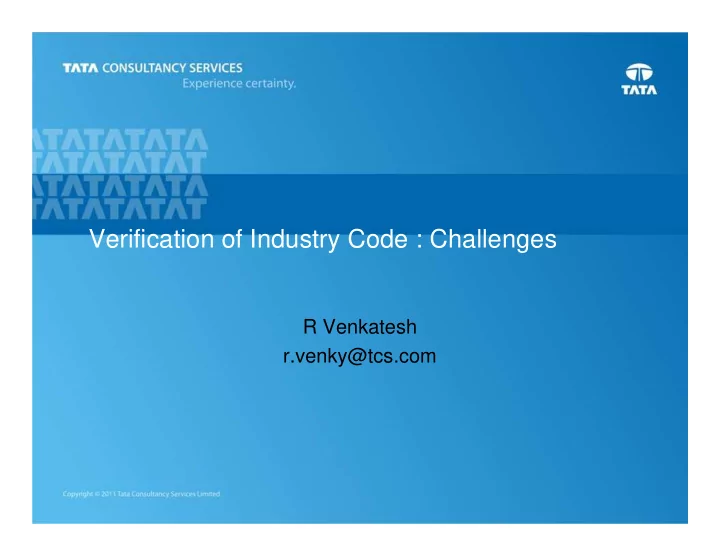

Verification of Industry Code : Challenges R Venkatesh r.venky@tcs.com 1
Overview � Focus of talk • Scalability problems in industry code • Ideas we are exploring � Formal verification @ TRDDC – Apply academic ideas to address quality related problems • Experiments and tools – Adapt as required – Adapt as required • Scale up • Specific solutions � Based on experiences with embedded software 2
Context � Finding bugs early in software � Model based development – Matlab Simulink – Statecharts – Code • Generated and hand written • Generated and hand written � Analysis and Testing – Most bugs can be found 3
Experience
Code Analysis � Standard + other properties – Zero division Code – Correct use of semaphores � Dataflow analysis + model Static Anal checking – Variable ranges from static – Variable ranges from static Model Model Checking analysis Error Report � Precision is the key challenge – Model checking does not scale up 5
Code Characteristics Application Size Key Characteristics FPS(ZD) Infotainment 2MLOC Large, large arrays(512), loops(unknown 77 (1 task) bounds) Smart card 7K Loops with large bounds and unknown 55 component bounds Several Upto - 0 36K 36K t = nondet_long(); j = nondet() * 2; while((t / sec_366) > 0) { for ( ; j < 512; j += 2) if( y % 4) t -= sec_365; elset -= sec_366; assert( j + 1 < 512); y++ ; } … assert (m < 12 ); 6
Test Generation � Code coverage – Modified Decision Condition Coverage C Code � Very similar to property checking – Most states will be reachable AutoGen – High coverage needed – High coverage needed – False positives not an issue Model checker � Scaling up is the key challenge Test Cases 7
Code Characteristics � Driver assist + odometer cluster � Generated code � Recursive code � Nested loops � Counters + floating operations while ( j++ <= 31 && !l) while ( j++ <= 31 && !l) for (i = 0; i <= 31; i++) if (*) while ( *) f(a[i]); recursion l = i; <counters>++; assert (counter < k ); while c(a[l], a[l + 1] ) l++; 8
Current Ideas being Explored
Loop Abstraction � Replace loops by small while (*) bounded loops o n = f(<io>); � One execution of body – Each distinct path – Distinct output variable for ( i in 1..n ) k = *; k = *; � � Recurrence relations Recurrence relations <io> = */recur(k); – Linear o n = f(<io>); � Naïve refinement 10
Guessing Invariants : Daikon � Generate random traces C Code � Guess invariants – Daikon Invariant Gen – Template based � Replace complex code by � Replace complex code by Test Gen invariants Test Cases � Works well in practice 11
Statecharts Analysis • Size Statemate Models • Per statechart • ~ 5 states, ~ 6-7 transitions • Translates to ~200 lines of C Dataport code • ~ 500 statecharts, composed in parallel Abstraction Techniques • • Real valued clock variables, ~ 1-2 per Real valued clock variables, ~ 1-2 per statechart Translator to SAL • Very long paths to reach some states • A fourth of the states did not reach in Verification Driver depth 50 (SAL-MCs) • loops in each statechart Simulation scripts for Counterexamples 12
Summary � Success – Scales up well to several thousand lines – Found several bugs • Production code • Medical, smart card, auto … � Limitations – Scalability • ECUs of millions of lines of code • ECUs of millions of lines of code • Financial software much bigger – Distributed systems • Multiple ECUs � Need order of magnitude scale up – Compositional, heuristics 13
Recommend
More recommend